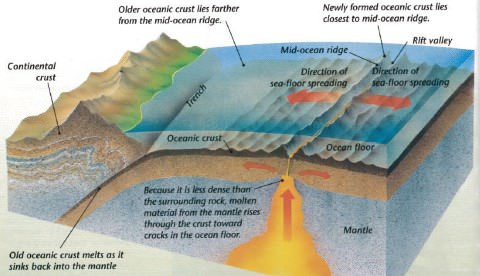Seafloor Spreading Theory Byju S

It leads to the formation of new material on the ridge.
Seafloor spreading theory byju s. Morgan later outlined the theory in 1968. Plate tectonics it was from the continental drift theory convection current theory and the theory of seafloor spreading the theory of plate tectonics was formulated. Mapping of sea floor in 1950s 3. The lithosphere which is the rigid outermost shell of our planet the crust and the upper mantle is broken up into tectonic.
The mid atlantic ridge for instance separates the north american plate from the eurasian plate and the south american plate from the african plate the east pacific rise is a mid ocean ridge that runs through the eastern pacific ocean and separates the pacific plate from the north american. This theoretical model is built on the concept of continental drift theory and the sea floor spreading theory. 3 questions raised after sea floor mapping 4. Seafloor spreading helps to explain continental drift in the theory of plate tectonics.
When oceanic plates diverge tensional stress causes fractures to occur in the lithosphere. Plate tectonics is a scientific theory that describes the large scale motion of the earth s lithosphere. To understand the concept of seafloor spreading we must first understand some basic concepts that form the cornerstones for the concept of seafloor spreading. According to the theory of plate tectonics the earth s lithosphere is broken into distinct plates which are.
Seafloor spreading was proposed by an american geophysicist harry h. Beginning of sea floor spreading theory 2. In 1963 fred vine and d h. Arthur holmes in 1930s discussed the possibility of convection currents.
Convection current theory convection current theory is the soul of seafloor spreading theory. The theory of seafloor spreading the mid ocean ridge is where the seafloor spreading occurs in which tectonic plates large slabs of earth s lithosphere split apart from each other. Seafloor spreading theory that oceanic crust forms along submarine mountain zones known collectively as the mid ocean ridge system and spreads out laterally away from them. As per seafloor spreading theory the mid oceanic ridge is the region where at the crest of oceanic ridges through the rupture of the oceanic crust and the crack continuous new lava eruption thrusts into it consequently pushing the oceanic crust on either side.
These cornerstones are convectional current theory and paleomagnetism. This idea played a pivotal role in the development of the theory of plate tectonics which revolutionized geologic thought during the last quarter of the 20th century. The motivating force for seafloor spreading ridges is tectonic plate slab pull at subduction zones rather than magma pressure although there is typically. Matthews used paleomagnetism to test the theory of seafloor spreading by studying paleomagnetic data from a portion of the midocean ridge system if the seafloor has spread laterally by the addition of new crust at the oceanic ridges there should be a relatively symmetrical pattern of magnetic orientation normal polarity reversed polarity normal polarity and.



















